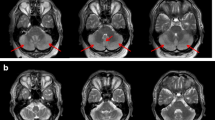Abstract
We report a case of a 17-year-old boy suffering from severe loin pain and oliguric acute kidney injury after strenuous exercise, with slightly elevated serum myoglobin and creatinine phosphokinase. Exercise-induced acute kidney injury (AKI) was diagnosed. We started intermittent hemodialysis thrice a week from the admission day. Four days later, he temporally lost consciousness, followed by visual agnosia and general clonic seizure. T2-weighted brain magnetic resonance images (MRI) showed multiple areas of increased signal intensity in the subcortical white matter, predominantly in the cerebrum of the posterior and parietal lobes and in the cerebellum. Clinical symptoms improved without sequelae. Follow-up MRI 1 month later showed complete resolution of the signals, and he was diagnosed with reversible posterior leukoencephalopathy syndrome (RPLS). This is the first reported case of exercise-induced AKI associated with RPLS. Vasoconstriction and endothelial dysfunction are considered as the common etiology of these diseases.

Similar content being viewed by others
References
Ishikawa I. Acute renal failure with severe loin pain and patchy renal ischemia after anaerobic exercise in patients with or without renal hypouricemia. Nephron. 2002;91:559–70.
Izumi M, Yokoyama K, Yamauchi A, Horio M, Imai E. A young man with acute renal failure and severe loin pain. Nephron. 1997;76:215–7.
Sanders LR. Exercise-induced acute renal failure associated with ibuprofen, hydrochlorothiazide, and triamterene. J Am Soc Nephrol. 1995;5:2020–3.
Han JS, Kim YG, Kim S, Lee MC, Lee JS, Kim SH. Bone scintigraphy in acute renal failure with severe loin pain and patchy renal vasoconstriction. Nephron. 1991;59:254–60.
Hinchey J, Chaves C, Appignani B, Breen J, Pao L, Wang A, et al. A reversible posterior leukoencephalopathy syndrome. N Engl J Med. 1996;334:494–500.
Lamy C, Oppenheim C, Meder JF, Mas JL. Neuroimaging in posterior reversible encephalopathy syndrome. J Neuroimaging. 2004;14:89–96.
Schwartz RB, Mulkern RV, Gudbjartsson H, Jolesz F. Diffusion-weighted MR imaging in hypertensive encephalopathy: clues to pathogenesis. AJNR Am J Neuroradiol. 1998;19:859–62.
Schnackenberg CG. Physiological and pathophysiological roles of oxygen radicals in the renal microvasculature. Am J Physiol Regul Integr Comp Physiol. 2002;282:R335–42.
Conflict of interest statement
None.
Author information
Authors and Affiliations
Corresponding author
About this article
Cite this article
Kimura, T., Iio, Ki., Imai, E. et al. Exercise-induced acute kidney injury with reversible posterior leukoencephalopathy syndrome. Clin Exp Nephrol 14, 173–175 (2010). https://doi.org/10.1007/s10157-009-0229-8
Received:
Accepted:
Published:
Issue Date:
DOI: https://doi.org/10.1007/s10157-009-0229-8




